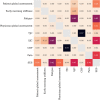Prognostic modeling in early rheumatoid arthritis: reconsidering the predictive role of disease activity scores
- PMID: 38536518
- PMCID: PMC11018671
- DOI: 10.1007/s10067-024-06946-z
Prognostic modeling in early rheumatoid arthritis: reconsidering the predictive role of disease activity scores
Abstract
Objective: In this prospective cohort study, we provide several prognostic models to predict functional status as measured by the modified Health Assessment Questionnaire (mHAQ). The early adoption of the treat-to-target strategy in this cohort offered a unique opportunity to identify predictive factors using longitudinal data across 20 years.
Methods: A cohort of 397 patients with early RA was used to develop statistical models to predict mHAQ score measured at baseline, 12 months, and 18 months post diagnosis, as well as serially measured mHAQ. Demographic data, clinical measures, autoantibodies, medication use, comorbid conditions, and baseline mHAQ were considered as predictors.
Results: The discriminative performance of models was comparable to previous work, with an area under the receiver operator curve ranging from 0.64 to 0.88. The most consistent predictive variable was baseline mHAQ. Patient-reported outcomes including early morning stiffness, tender joint count (TJC), fatigue, pain, and patient global assessment were positively predictive of a higher mHAQ at baseline and longitudinally, as was the physician global assessment and C-reactive protein. When considering future function, a higher TJC predicted persistent disability while a higher swollen joint count predicted functional improvements with treatment.
Conclusion: In our study of mHAQ prediction in RA patients receiving treat-to-target therapy, patient-reported outcomes were most consistently predictive of function. Patients with high disease activity due predominantly to tenderness scores rather than swelling may benefit from less aggressive treatment escalation and an emphasis on non-pharmacological therapies, allowing for a more personalized approach to treatment. Key Points • Long-term use of the treat-to-target strategy in this patient cohort offers a unique opportunity to develop prognostic models for functional outcomes using extensive longitudinal data. • Patient reported outcomes were more consistent predictors of function than traditional prognostic markers. • Tender joint count and swollen joint count had discordant relationships with future function, adding weight to the possibility that disease activity may better guide treatment when the components are considered separately.
Keywords: Linear regression; Outcome assessment; Patient reported outcome; Precision medicine; Prognosis; Rheumatoid arthritis.
© 2024. The Author(s).
Conflict of interest statement
AB and LAS are funded by an unrestricted training grant from GSK plc, supervised by LOR and LJP. The other authors have disclosed no conflicts of interest.
Figures



Similar articles
-
Functional improvement after patients with rheumatoid arthritis start a new disease modifying antirheumatic drug (DMARD) associated with frequent changes in DMARD: the CORRONA database.J Rheumatol. 2008 Oct;35(10):1966-71. Epub 2008 Sep 1. J Rheumatol. 2008. PMID: 18785317 Free PMC article.
-
The longitudinal effect of biologic use on patient outcomes (disease activity, function, and disease severity) within a rheumatoid arthritis registry.Clin Rheumatol. 2019 Nov;38(11):3081-3092. doi: 10.1007/s10067-019-04649-4. Epub 2019 Jul 29. Clin Rheumatol. 2019. PMID: 31353421
-
Disability measured by the modified health assessment questionnaire in early rheumatoid arthritis: prognostic factors after two years of follow-up.Clin Exp Rheumatol. 2009 Mar-Apr;27(2):284-91. Clin Exp Rheumatol. 2009. PMID: 19473570
-
Assessing prognosis and prediction of treatment response in early rheumatoid arthritis: systematic reviews.Health Technol Assess. 2018 Nov;22(66):1-294. doi: 10.3310/hta22660. Health Technol Assess. 2018. PMID: 30501821 Free PMC article.
-
Measures of activity and damage in rheumatoid arthritis: depiction of changes and prediction of mortality over five years.Arthritis Care Res. 1997 Dec;10(6):381-94. doi: 10.1002/art.1790100606. Arthritis Care Res. 1997. PMID: 9481230 Review.
References
-
- Bansback N, Young A, Brennan A, Dixey J. A prognostic model for functional outcome in early rheumatoid arthritis. J Rheumatol. 2006;33:1503–1510. - PubMed
-
- Scott DL, Smith C, Kingsley G. Joint damage and disability in rheumatoid arthritis: an updated systematic review. Clin Exp Rheumatol. 2003;21:S20–S27. - PubMed
MeSH terms
Substances
Grants and funding
LinkOut - more resources
Full Text Sources
Medical
Research Materials

